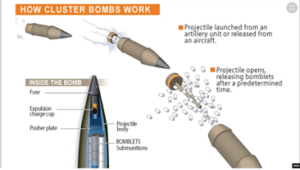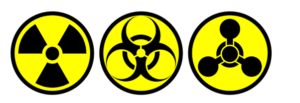Stop the fence-sitting in cluster bomb use.
Relevance:
- GS Paper 2/ GS Paper 3
- Important international Institution
- Defence and technology
News: The recent decision by the United States to provide cluster munitions to Ukraine as part of a military aid package has ignited a contentious debate over the ethics and legality of their use.
Cluster Bombs: A Deadly Legacy-
Definition and Impact:
- Cluster bombs are weapons that release numerous explosive submunitions, or bomblets, upon deployment. These submunitions cause widespread devastation upon impact, posing a severe threat to civilians and infrastructure.
- Cluster munitions have had a high dud rate. It means that thousands of the smaller unexploded bomblets can remain unexploded and can kill and maim people decades later.
Range: Strike targets 15 to 20 miles (24 to 32 kilometers) away.
- Lingering Threat: Many bomblets do not detonate upon impact, remaining dormant for years and acting as de facto landmines, endangering civilian lives over extended periods.
- Cluster Bomb Supply: The U.S.’s decision to supply cluster bombs to Ukraine, raises ethical concerns. The argument of low dud rates is contested.
- Ukraine’s Conundrum: Amidst the ongoing conflict with Russia, Ukraine’s use of cluster bombs intensifies the humanitarian crisis, exacerbating civilian casualties and damage to vital infrastructure.
Cluster Munition and India-
- India is not a signatory to the Convention on Cluster Munition but the government acknowledges the humanitarian concerns associated with these weapons.
- India considers cluster bombs as legitimate tools and both manufactures and exports them. However India has never used them.
- The human cost of cluster bombs in India: In the 2009 bombing of the village of Gumrah in Chhattisgarh, which killed at least 13 civilians, including several children cluster bomb was used.
Convention on Cluster Munitions-
- Global Ban by UN: The Convention on Cluster Munitions, sanctioned by the United Nations, strictly prohibits cluster munition use, production, transfer, and stockpiling.
- Aid and Cooperation Focus: The convention also outlines cooperative efforts for survivor support, contaminated area clearance, risk education, and stockpile destruction.
- Origin and Enactment: Originating in Dublin, Ireland, the convention was adopted in 2008 and opened for signature in Oslo, Norway. It took effect in 2010 after 30 ratifications.
- Broad Participation: With 110 State Parties and 13 Signatory States, the convention demonstrates broad international involvement.
- Commitments for Ratifying Nations: Ratifying countries commit to never using or dealing with cluster munitions, ensuring these weapons are not developed, produced, or stockpiled.
- India: India, along with the US, Russia, China, Pakistan, and Israel, has not joined the convention as a non-signatory and non-party.
Other International Conventions for weapon of mass Destruction-
International laws on Biological weapons:
- Early Efforts: The first steps towards international regulation of biological weapons emerged with the 1925 Geneva Protocol. This protocol prohibited their use while permitting possession and development.
- Biological Weapons Convention (BWC): In 1972, the Biological Weapons Convention (BWC) was established as a comprehensive international treaty. It bars the creation, deployment, or accumulation of biological weapons. Presently, the BWC boasts 183 States Parties as of March 2021.
- Australia Group: The Australia Group, established in 1985, is a collective effort of 43 nations. This multilateral export control initiative strives to counter the proliferation of chemical and biological weaponry.
- UN Security Council Resolution 1540: In 2004, the United Nations Security Council introduced Resolution 1540. This resolution mandates all UN Member States to enact and enforce appropriate legal measures against the spread of chemical, biological, radiological, and nuclear weapons, particularly thwarting their distribution to non-state actors.
International laws on Chemical Weapon-
- Early Measures: The 1899 Hague Convention initiated restrictions against chemical weapons.
- Washington Naval Treaty (1922): The 1922 Five-Power Treaty aimed at chemical warfare eradication, but France’s rejection hindered its success.
- Geneva Protocol (1925): The 1925 Geneva Protocol banned both chemical and biological weapons.
- Chemical Weapons Convention (CWC – 1993): The 1993 CWC, a potent international treaty, forbids chemical weapons’ development, production, stockpiling, and use. Administered by the OPCW, headquartered in The Hague.
International laws on Nuclear Weapons-
- Proliferation and Environmental Concerns (1960s): During the 1960s, efforts emerged to curb nuclear weapon proliferation and mitigate environmental impacts of testing.
- Partial Nuclear Test Ban Treaty (1963): The 1963 treaty confined nuclear testing exclusively to underground locations, preventing nuclear fallout contamination.
- Treaty on the Non-Proliferation of Nuclear Weapons (NPT – 1968): This treaty aimed to limit signatories’ activities, enabling the transfer of non-military nuclear technology without proliferation concerns.
- International Atomic Energy Agency (IAEA – 1957): Established by the UN, the IAEA promotes peaceful nuclear technology use, safeguards against misuse, and fosters safety measures.
- Comprehensive Nuclear-Test-Ban Treaty (CTBT – 1996): Introduced in 1996, the CTBT bans all nuclear testing, obstructing nuclear arms development by compliant nations.
- India’s Stance: While India hasn’t signed the Nuclear Non-proliferation Treaty, it is a signatory of the Biological Weapons Convention and Chemical Weapons Convention.
The use of cluster bombs in modern warfare remains a deeply contentious issue. The international legal framework, exemplified by the Convention on Cluster Munitions, highlights the collective responsibility to prevent civilian suffering. As the world grapples with the aftermath of cluster bomb use, it becomes increasingly imperative for nations to unite in rejecting these weapons and striving for a safer, more humane future.
Mains Question:
Q Discuss the human cost of cluster bombs. What is Convention on Cluster Munitions (CCM)? 250 words.





